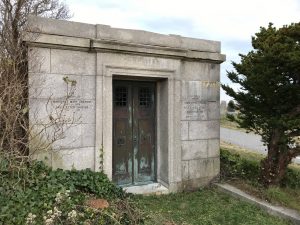[Editor's note: The following blog post appeared in Vita Brevis on 6 December 2019.]
 Having been occupied with a project these last few months, not only have I been away from Vita Brevis for far too long, but I’ve allowed issues of the Weekly Genealogist to pile up in my in box. In truth, I do open them each week to add my vote to the survey, but until the other day I had not had the opportunity to read them start to finish. While each issue is always brimming with interesting things, I particularly enjoy the Stories of Interest. And so, as I binged on my backlog of six weeks, a story from October 2 about the town of Ashland, Massachusetts recovering its long lost Boston Post cane caught my eye.
Having been occupied with a project these last few months, not only have I been away from Vita Brevis for far too long, but I’ve allowed issues of the Weekly Genealogist to pile up in my in box. In truth, I do open them each week to add my vote to the survey, but until the other day I had not had the opportunity to read them start to finish. While each issue is always brimming with interesting things, I particularly enjoy the Stories of Interest. And so, as I binged on my backlog of six weeks, a story from October 2 about the town of Ashland, Massachusetts recovering its long lost Boston Post cane caught my eye.
The Boston Post cane was a publicity stunt orchestrated in 1909 by Edwin Atkins Grozier, who had purchased a controlling interest in the daily newspaper in 1891. In an effort to boost readership, he distributed 700 walking canes to towns across New England (though it seems that Vermont and Connecticut were not included), and entrusted the selectmen of each town to present the cane – compliments of the Boston Post – to the oldest male citizen. (Not until 1930 were women eligible for the cane.) Made of ebony from the Congo, the polished canes were crowned with a 14-carat gold head engraved with the inscription: Presented by The Boston Post to the oldest citizen of [name of town]. (To be transmitted). The “stunt” must have worked because the Post, originally founded in 1831, grew into one of New England’s largest newspapers under Grozier’s savvy stewardship and continued to earn prestige and readership after his son Richard took over.
As a kid growing up summers in Provincetown on Cape Cod, there was a home on Commercial Street that I stopped to admire whenever I made my way into town.[1] It gleamed a pristine white in the Provincetown sunshine and seemed far more opulent than the humble Cape Cod-style homes that defined the town. The roof was topped with an octagonal cupola – what some call a widow’s walk – that had an unimpeded view of the harbor and bay. Illuminated at night, we were convinced that we saw the ghost of a long-dead sea captain’s widow, she having never given up hope that her husband might return.
It gleamed a pristine white in the Provincetown sunshine and seemed far more opulent than the humble Cape Cod style homes that defined the town.
Everyone knew the house as the “Grozier” house, once the home of Edwin Atkins Grozier, who died in 1924, and his wife, Alice Goodell Grozier, who lived until 1943. The Grozier family continued to occupy the house until the 1960s, when it was sold. I had a personal connection of sorts to the house. My Dad, in his youth, had worked for the family, maintaining the grass at Grozier Park, the waterfront park across the street where the Central Wharf once stood. Alas, by my time that open space, sloping down to the beach, had been filled from edge to edge with a motel.
Built circa 1840 by Captain Joseph Atkins (1766–1851) – who had also built the Central Wharf – the house passed to Joseph’s son, William A. Atkins (1818–1897), who made his fortune during Provincetown’s whaling heyday. After the death on 25 August 1842 of his first wife, twenty-two year-old Abigail (Freeman), who likely died after giving birth (a child, William, died at the age of two months on 5 August),[2] William A. Atkins married Jane Freeman Grozier (1819–1886), whose brother, Captain Joshua Freeman Grozier (1825–1883), was the father of Edwin Atkins Grozier. When he was a young boy, Edwin and his family lived with William and Jane Atkins. Edwin and Alice later bought the “Grozier” house from the Atkins family.
Recently, I was doing a talk at a local library, and a lively discussion ensued, turning to the joys and frustrations of genealogy. One woman offered that genealogy is a “rabbit hole,” a term coined by Lewis Carroll in his Alice’s Adventures in Wonderland. While the expression can have its negative connotations, for genealogists it is less fraught, more often used as a metaphor for following our curiosity and the (welcome) distractions that we tumble into when we give flight to that curiosity.
If, in our rabbit hole, we are unlikely to encounter the fantastical anthropomorphic characters that entertained Alice, the genealogical rabbit hole is no less a wonderland and proof that the real events of people’s lives often make for stories as remarkable and as strange as fiction. And so, one night, there I was, falling, falling, falling, into the rabbit hole of Edwin Atkins Grozier’s ancestry.
If, in our rabbit hole, we are unlikely to encounter the fantastical anthropomorphic characters that entertained Alice, the genealogical rabbit hole is no less a wonderland...
Grozier’s paternal ancestry seems to begin with a William Grozier (Grozer), born about 1689, possibly in England,[3] and married in Boston to Joanna Burell. His death in September 1734 at the age of forty-five is recorded in the records of Christ Church in Boston (better known as the Old North Church of Paul Revere fame). Four children, as well as Joanna as an adult, were baptized at Christ Church in December 1734, just months after William’s death. A fifth child, John, was baptized in May 1735.
In 1756, John Grozier married Truro-born Mercy Hopkins, a fourth-generation Cape Codder. She was the great-granddaughter of Mayflower passenger Stephen Hopkins.
Nine children were born to John and Mercy, three of whom died young, including two sons named Joshua. Joshua Freeman Grozier, born 2 April 1769, was the third son to take the name Joshua.[4] In 1793 he married Martha “Patty” Cook, the daughter of Jonathan Cook (also a Hopkins descendant) and Mercy Tilton. Joshua and Martha had ten children, the first of whom was William, born in 1794.[5] Married in 1817 to Rebecca Perry, they were the parents of six children, including Jane Freeman (Grozier) Atkins and Joshua Freeman Grozier.[6]
In 1856, Joshua Freeman Grozier, the master of a clipper ship that sailed around the Horn from New York to San Francisco, married twenty-two year-old Mary Louise Given (1835–1919), whose father, Saint-Vincent Given, was a prominent Bowdoinham, Maine sea captain, ship owner, and shipbuilder. The couple married in Lima, Peru, and one has to wonder if she was sailing with her father at the time. Joshua’s younger brother, William U. Grozier (1835–1916), a master mariner and Civil War veteran, married Josephine Given, Mary Louise’s younger sister. Josephine’s 1925 obituary, printed in the Denver Post – she had moved to Colorado to be near her son – referred to her as a “Woman Rover of Land and Sea,” noting that she had sailed with her husband for years and had escaped many perils unscathed.
Josephine’s 1925 obituary ... referred to her as a “Woman Rover of Land and Sea,” noting that she had sailed with her husband for years and had escaped many perils unscathed.
Six children were born to Joshua Freeman Grozier and Mary Louise Given who, like her sister Josephine, was a woman with a taste for adventure.[7] At least four of the six children were born at sea between 1858 and 1873. An advertisement for the “very superior medium clipper ship” Commonwealth, Joshua F. Grozier, Commander, shows her preparing to sail to San Francisco from Lewis Wharf in Boston in April 1859. Edwin Atkins Grozier was born at the entrance of the Golden Gate on 12 September 1859, and it is quite certain that the voyage advertised is the voyage during which Mary Louise gave birth.
Edwin Atkins Grozier died at his Cambridge home on 9 May 1924. A train from Boston bearing Grozier and the funeral party arrived in Provincetown, where, “among the sand dunes back of the Pilgrim monument in the ancient burying ground wherein sea captains of old sleep,” he was laid to rest in a family tomb.[8]
Though the Boston Post folded in 1956, Provincetown is one of the New England towns that continues the tradition of presenting its Boston Post cane to the oldest citizen, the current recipient of the cane – a woman – having received it this past June. Edwin Atkins Grozier is probably smiling down.
* * *
Author’s note: Visit The Boston Post Cane Information Center online to learn more about the tradition.
Notes
[1] 160 Commercial Street (formerly 157 Commercial Street).
[2] Hamilton Cemetery, Atkins family plot, #48.
[3] One biographical reference for Edwin Atkins Grozier refers to his agnate descent from a French Protestant immigrant to Boston.
[4] Mayflower Families Through Five Generations: Stephen Hopkins.
[5] Ibid.
[6] Ancestry.com. Massachusetts, Town and Vital Records, 1620-1988 [database on-line].
[7] Josephine Sandford Ware, Robert Sandford and His Wife Ann Adams Sandford With Some of Their Descendants 1615–1930 (Rutland: The Tuttle Company), 48.
[8] ”E.A. Grozier Buried at Provincetown,” The Boston Herald, 13 May 1924, 24.
Share this:

About Amy Whorf McGuiggan
Amy Whorf McGuiggan recently published Finding Emma: My Search For the Family My Grandfather Never Knew; she is also the author of My Provincetown: Memories of a Cape Cod Childhood; Christmas in New England; and Take Me Out to the Ball Game: The Story of the Sensational Baseball Song. Past projects have included curating, researching, and writing the exhibition Forgotten Port: Provincetown’s Whaling Heritage (for the Pilgrim Monument and Provincetown Museum) and Albert Edel: Moments in Time, Pictures of Place (for the Provincetown Art Association and Museum).View all posts by Amy Whorf McGuiggan →